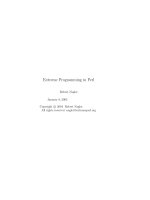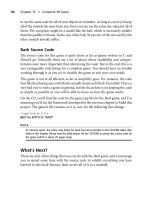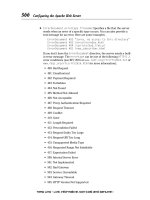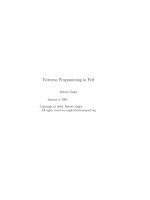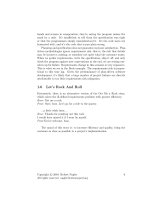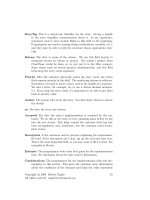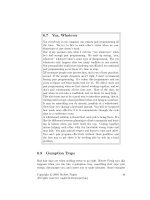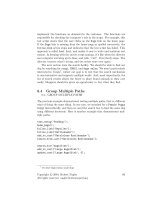Extreme Programming in Perl Robert Nagler phần 9 pps
Bạn đang xem bản rút gọn của tài liệu. Xem và tải ngay bản đầy đủ của tài liệu tại đây (281.18 KB, 22 trang )
14.8 Stylin’
Coding style is important to consider when refactoring. In this
chapter, I chose to maintain the style of the source.
a
To contrast,
here’s what access would look like in bOP style:
sub
a
ccess my(field,self, value) = @
;
return @
>
= 3?self->field =value : self− > field;T hedifferencesbetweenthetwostylesar esubtle, butthebOP versionwouldstandoutinthecodeandbeanunnecessarydistr action.N oonecaresif youuse$me, $self, or$i
b
aslongasyouareconsistent.Style updates are important, too. If for some reason, Mail::POP3Client were to be incorporated into bOP, we would consider updating the implementation to match bOP style. Refactoring coding style is fine as long as you refactor and test independently from other changes.
a
There are some minor changes to whitespace, indentation, and brace
placement for consistency and brevity within this book.
b
Except in FORTRAN, where the name of the variable can determine its
type.
14.9 Tactics Versus Strategy
When we begin a task, tactics are important. We want to add business value
as quickly as possible. Doing the simplest thing that could possibly work is
a tactic to reach our goal.
Copy-and-paste is the weapon of choice when task completion is our
only objective. Generalizations, such as the refactorings shown thus far, are
not easy to come up with when you’re under pressure to get the job done.
Besides, you don’t know if the code you copy solves the problem until the
implementation is finished. It’s much better to copy-and-paste to test an
idea than to invent, to implement, and to use the wrong abstraction.
As a design strategy, copy-and-paste poses problems. The code is more
difficult to comprehend, because it’s difficult to see subtle differences. Faults
fixed in one place do not propagate themselves automatically. For example,
there’s an alternative fix to the problem already embedded in two other ac-
cessors, Count and Size:
sub Count {
my $me = shift;
my $c = shift;
if (defined $c and length($c) > 0) {
$me->{COUNT} = $c;
} else {
return $me->{COUNT};
}
}
Copyright
c
2004 Robert Nagler
All rights reserved
134
sub Size {
my $me = shift;
my $c = shift;
if (defined $c and length($c) > 0) {
$me->{SIZE} = $c;
} else {
return $me->{SIZE};
}
}
These accessors behave differently from the other eight that we refactored
and fixed above. Count and Size need to be resettable to zero (mailboxes
can be empty), which is why the accessors have an alternate implementation.
The thought and debugging that went into fixing Count and Size could
have also applied to the other accessors. Since the code wasn’t refactored at
the time of the fix, it was probably easier to leave the other accessors alone.
And, under the principle of “if it ain’t broke, don’t fix it” any change like
this is not justified.
XP legitimatizes fixing non-broke code. It’s something programmers do
anyway, so XP gives us some structure and guidelines to do it safely. We
can refactor Size and Count to use access without fear.
4
The unit test
covers the empty mailbox case. If we didn’t have a test for this case, we
could add one. Again, XP saves us. Since the programmers are the testers,
we’re free to modify the test to suit our needs.
14.10 Refactor With a Partner
Pair programming supports refactoring, too. Two people are better than one
at assessing the need for, the side-effects of, and the difficulty of a change.
The tradeoffs between tactics versus strategy are hard, and discussing them
with a partner is both effective and natural. Switching partners often brings
new perspectives to old code, too.
Sometimes I look at code and don’t know where to begin refactoring.
The complexity overwhelms my ability to identify commonality. For exam-
ple, here’s some code which needs refactoring:
4
When making changes to CPAN modules, XP, nor any other methodology, helps to
validate uses in the (unknown) importers.
Copyright
c
2004 Robert Nagler
All rights reserved
135
sub List {
my $me = shift;
my $num = shift || ’’;
my $CMD = shift || ’LIST’;
$CMD=~ tr/a-z/A-Z/;
$me->Alive() or return;
my @retarray = ();
my $ret = ’’;
$me->_checkstate(’TRANSACTION’, $CMD) or return;
$me->_sockprint($CMD, $num ? " $num" : ’’, $me->EOL());
my $line = $me->_sockread();
unless (defined $line) {
$me->Message("Socket read failed for LIST");
return;
}
$line =~ /^\+OK/ or $me->Message("$line") and return;
if ($num) {
$line =~ s/^\+OK\s*//;
return $line;
}
while (defined($line = $me->_sockread())) {
$line =~ /^\.\s*$/ and last;
$ret .= $line;
chomp $line;
push(@retarray, $line);
}
if ($ret) {
return wantarray ? @retarray : $ret;
}
}
sub ListArray {
my $me = shift;
my $num = shift || ’’;
my $CMD = shift || ’LIST’;
$CMD=~ tr/a-z/A-Z/;
$me->Alive() or return;
my @retarray = ();
my $ret = ’’;
$me->_checkstate(’TRANSACTION’, $CMD) or return;
Copyright
c
2004 Robert Nagler
All rights reserved
136
$me->_sockprint($CMD, $num ? " $num" : ’’, $me->EOL());
my $line = $me->_sockread();
unless (defined $line) {
$me->Message("Socket read failed for LIST");
return;
}
$line =~ /^\+OK/ or $me->Message("$line") and return;
if ($num) {
$line =~ s/^\+OK\s*//;
return $line;
}
while (defined($line = $me->_sockread())) {
$line =~ /^\.\s*$/ and last;
$ret .= $line;
chomp $line;
my($num, $uidl) = split ’ ’, $line;
$retarray[$num] = $uidl;
}
if ($ret) {
return wantarray ? @retarray : $ret;
}
}
sub Uidl {
my $me = shift;
my $num = shift || ’’;
$me->Alive() or return;
my @retarray = ();
my $ret = ’’;
$me->_checkstate(’TRANSACTION’, ’UIDL’) or return;
$me->_sockprint(’UIDL’, $num ? " $num" : ’’, $me->EOL());
my $line = $me->_sockread();
unless (defined $line) {
$me->Message("Socket read failed for UIDL");
return;
}
$line =~ /^\+OK/ or $me->Message($line) and return;
if ($num) {
$line =~ s/^\+OK\s*//;
return $line;
Copyright
c
2004 Robert Nagler
All rights reserved
137
}
while (defined($line = $me->_sockread())) {
$line =~ /^\.\s*$/ and last;
$ret .= $line;
chomp $line;
my($num, $uidl) = split ’ ’, $line;
$retarray[$num] = $uidl;
}
if ($ret) {
return wantarray ? @retarray : $ret;
}
}
Where are the differences? What’s the first step? With a fresh perspec -
tive, the following stood out:
sub Uidl {
my $me = shift;
my $num = shift;
return $me->ListArray($num, ’UIDL’);
}
A partner helps you overcome familiarity and fear of change which make
it hard to see simplifications like this one.
14.11 Sharing with Code References
It’s clear that List and ListArray are almost identical. The problem is
that they differ in the middle of the loop. Perl code references are a great
way to factor out differences especially within loops:
sub List { return list( sub { my $line = shift; my $retarray =
shift; push(@$retarray, $line); return; }, @ , ); } sub ListArray
{ return list( sub { my($num, $value) = split ’ ’, shift; my $retarray
= shift; $retarray->[$num] = $value; return; }, @ , ); } sub list
{ my $parse line = shift;
my $me = shift;
Copyright
c
2004 Robert Nagler
All rights reserved
138
my $num = shift || ’’;
my $CMD = shift || ’LIST’;
$CMD =~ tr/a-z/A-Z/;
$me->Alive() or return;
my @retarray = ();
my $ret = ’’;
$me->_checkstate(’TRANSACTION’, $CMD) or return;
$me->_sockprint($CMD, $num ? " $num" : ’’, $me->EOL());
my $line = $me->_sockread();
unless (defined $line) {
$me->Message("Socket read failed for $CMD");
return;
}
$line =~ /^\+OK/ or $me->Message("$line") and return;
if ($num) {
$line =~ s/^\+OK\s*//;
return $line;
}
while (defined($line = $me->_sockread())) {
$line =~ /^\.\s*$/ and last;
$ret .= $line;
chomp $line; $parse line->($line, \@retarray);
}
if ($ret) {
return wantarray ? @retarray : $ret;
}
}
We pass an anonymous subroutine as list’s first parameter, $parse line,
for the reason described in Refactor Then Fix.
14.12 Refactoring Illuminates Fixes
The List, ListArray, and Uidl methods are bimodal. When called without
arguments, they return a list of values. When passed a message number,
the value for that message number alone is returned. The message numb er
cases failed in our unit test.
The code reference refactoring shows us where the fault lies: $parse line
Copyright
c
2004 Robert Nagler
All rights reserved
139
is not called when list is called with an argument. It also needs to chomp
the $line to match the behavior:
if ($num) {
$line =~ s/^\+OK\s*//; chomp $line; return $parse line->($line);
}
The anonymous subroutines in List and ListArray need to be bimodal
for this refactoring to work:
sub List {
return _list(
sub {
my $line = shift;
my $retarray = shift or return $line;
push(@$retarray, $line);
return;
},
@_,
);
}
sub ListArray {
return _list(
sub {
my($num, $value) = split ’ ’, shift; my $retarray = shift
or return $value;
$retarray->[$num] = $value;
return;
},
@_,
);
}
By compressing the business logic, its essence and errors become apparent.
Less code is almost always better than more code.
While advanced constructs like code references may be difficult to un-
derstand for those unfamiliar with them, dumbing down the code is not a
Copyright
c
2004 Robert Nagler
All rights reserved
140
good option. Defaulting to the least common denominator produces dumb
code and ignorant programmers. In XP, change occurs not only the project
artifacts but also in ourselves. Learning and teaching are an integral part
of the XP methodology.
14.13 Brush and Floss Regularly
This chapter presents a glimpse of design on demand. Each refactoring was
implemented and tested separately. The trick to refactoring successfully is
taking baby steps.
I like to compare refactoring to brushing your teeth. Your best shot at
preventing tooth decay is to brush briefly after each meal and to floss daily.
Alternatively, you c ould just wait for cavities to appear and have them filled.
The short term cost in pain, money, and time is much greater if you do. In
the long term, too many fillings create structural problems and the tooth
has to be replaced.
Refactoring is preventative maintenance, like tooth brushing. Quick fixes
are like fillings. Eventually, they create structural problems and require the
implementation to be replaced. Like teeth, complete rewrites are unneces-
sarily painful and costly.
XP encourages you to do the simplest thing that could possibly work
(tactics) to address the immediate problem . You refactor your code to ex-
press concepts once and only once (strategy) to prevent structural problems.
And, don’t forget that brushing and flossing support pair programming.
Copyright
c
2004 Robert Nagler
All rights reserved
141
Copyright
c
2004 Robert Nagler
All rights reserved
142
Chapter 15
It’s a SMOP
Representation is the essence of programming.
– Fred Brooks
Implementing Extreme Perl is a simple matter of programming. Prac-
ticing XP clarifies its values. Perl’s virtues come alive as you read and write
it. The subject matter language crystallizes as the subject matter oriented
program evolves along with the programmers’ mastery of the problem do-
main.
This chapter coale sc es the book’s themes (XP, Perl, and SMOP) into a
single example: a DocBook XML to HTML translator. We walk through
the planning game, split the story into tasks, discuss coding style, design
simply, pair program, test first, and iterate. The subject matter oriented
program (SMOP) is a hash of XML to HTML tags interpreted by a declar-
ative algorithm. Along the way, declarative programming is defined and
related to other paradigms (object-oriented and imperative programming).
15.1 The Problem
The example in this chapter converts DocBook XML
1
(the source form of
this book) to HTML. The example went beyond this chapter, and the version
here was enhanced to produce the review copies for the entire book.
2
DocBook is a technical document description language. I described the
paragraphs, sections, terms, etc. of this book with tags as follows:
1
DocBook: The Definitive Guide by Norman Walsh and Leonard Muellner, available
online at />2
The most recent version is available with bOP.
143
<blockquote><para>
To learn about <firstterm>XML</firstterm>, visit
<systemitem role="url"> /></para></blockquote>
It’s unreadable in source form, and my resident reviewer in chief pointed
this out after I asked her to review the first chapter in source form. She was
expecting something like this:
To learn about XML, visit />Since eating your own dog food is a great way to make sure it’s palatable,
my resident reviewer in chief agreed to act as the on-site c ustomer
3
for a
DocBook to HTML translator.
I am happy to say she is satisfied with the output of the program.
4
15.2 Planning Game
The planning game was brief. There was only one story card (shown com-
pleted):
The Story Card
3
To be sure, I added it to her wedding vows ex post facto.
4
One reviewer would have preferred Perl POD. However, XP only works w hen the
customer speaks in one voice, so I ignored him for the s ake of matrimonial harmony.
Copyright
c
2004 Robert Nagler
All rights reserved
144
Note the simplicity of the story. One sentence is usually sufficient to
describe the problem.
During the planning game, we decided almost immediately the output
would be HTML. We briefly discussed simply stripping the XML tags to
produce a plain text document. We dropped this idea quickly, because
the output would not be very easy to read, for example, footnotes would
appear in the middle of the text. We touched on alternative formatting
languages, such as, Rich Text Format (RTF), but the simplicity of HTML
and its relatedness to XML made the decision for us. HTML provides enough
formatting to give a sense of the layout, which is all Joanne needed to read
and print the chapters.
15.3 Dividing the Story into Tasks
We already had a chapter as a sample input. This made it easy to define the
tasks. I needed the tasks to be bite-sized chunks, because my programming
partners were only available for brief periods.
The task split was simple. I scanned the chapter looking for problematic
tags. The first task specifies simple tags. The other tasks specify one prob-
lematic tag each. Only DocBook tags used in the chapter were included,
and each tag can be found in at least one test case.
Copyright
c
2004 Robert Nagler
All rights reserved
145
15.4 Coding Style
The story card does not mention declarative programming. It also doesn’t
specify what language, operating system, or hardware is to be used. The
customer simply wants readable and printable chapters. She doesn’t care
how we do it.
Too often we begin coding without an explicit discussion about how we’re
going to code, that is. what language and what style. For this project, we
chose Perl for the following reasons:
• XML maps naturally to Perl’s built-in data structures (lists and hashes),
• CPAN has several ready-to-use XML parsers,
• It’s easy to generate HTML in Perl, and
• I needed an example for this book.
The last reason is important to list. One of the core values of XP is
communication. By listing my personal motivation, I’m being honest with
my team. Miscommunication often comes from hidden agendas.
15.5 Simple Design
The problem lends itself to simplicity. XML and HTML are declarative
languages, and an important property of declarative languages is ease of
manipulation. For example, consider the following DocBook snippet:
<para>
<classname>XML::Parser</classname> parses XML into a tree.
</para>
The relationships are clear, and the mapping to HML is simply:
<p>
<tt>XML::Parser</tt> parses XML into a tree.
</p>
One could translate the tags with a simple tag for tag mapping, such as:
Copyright
c
2004 Robert Nagler
All rights reserved
146
s{<(/?)para>}{<$1p>}g;
s{<(/?)classname>}{<$1tt>}g;
This design is too simple, however. It assumes the XML is well-formed,
which it often isn’t when I write it. For example, if I were to leave off
</classname>, the closing </tt> would be m issing in the HTML, and the
output would be in tt font for the rest of the document. The classic re-
sponse to this is: garbage in, garbage out. However, we did better without
added complexity
5
, and the solution evolved with minimal changes.
We favored hubris and impatience over doing the simplest thing that
could possibly work. A little chutzpah is not bad every now and then as long
as you have b enchmarks to measure your progress. If the implementation
size grew too rapidly, we would have backed off to the simpler solution. If
blew our task estimates, we’d have to ask if we didn’t under-estimate the
complexity of the more radical approach.
The design we chose starts with the output of the CPAN package, XML::Parser.
If the XML is not well-formed, XML::Parser dies. There is no output when
the input is garbage.
XML::Parser preserves the semantic structure of the input. The trans-
lation is an in-order tree traversal, so the output is likely to be well-formed
HTML, which also is a tree.
15.6 Imperative versus Declarative
To help understand the benefits of declarative languages, let’s consider an
alternate problem. Suppose I was writing this book in troff
6
, an impera-
tive text formatting language:
.PP
\fBXML::Parser\fR parses XML into a tree.
The commands in troff are not relational. The .PP does not bracket the
5
One of the reviewers implemented the s imple approach, and the two solutions are of
comparable size and complexity.
6
troff is a text-formatting language for UNIX man pages and other doc-
uments. After 25 years, it’s still in use. For more information, visit
/>Copyright
c
2004 Robert Nagler
All rights reserved
147
paragraph it introduces. troff interprets the .PP as a paragraph break, and
what follows need not be a paragraph at all. The command is imperative,
because it means do something right now irrespective of context.
The \fB and \fR commands do not relate to the value they surround,
either. \fB turns on bold output, and \fR turns off all emphasis statefully.
Drop one or the other, and the troff is still well-formed. troff commands
are unrelated to one another except by the order in which they appear in
the text.
Writing a troff parser is straightforward. The complete grammar is
not much more complicated than the example above. Translating troff to
HTML is much more difficult.
7
For example, consider the following troff:
\fBXML::Parser\fI is sweet!\fR
The equivalent HTML is:
<b>XML::Parser</b><i> is sweet!</i>
A simple command-to-tag translation is insufficient. The program must
maintain the state of the font in use, and output the co rresponding closing
tag (</b>) when the font changes before appending the font tag (<i>). The
same is true for font sizes, indentation level, line spacing, and other stateful
troff com mands. The program has to do two jobs: map commands to tags
and emulate the state management of troff.
As you’ll see, the XML to HTML translator does not maintain global
input state to perform its job. The XML tags are translated based on
minimal local context only. The only relational information required is the
parent of the current tag. The mapping is stateless and therefore simpler
due to XML’s declarativeness.
7
Eric Raymond’s doclifter performs an even more herculean task: the program con-
verts troff to DocBook. doclifter uses the implicit relations of common usage patterns
to extract higher-level semantics, such as, knowing that man page references usually match
the regular expression: /\w+\(\d+\)/. The 6,000 line program is written declaratively in
Python, and can be downloaded from />Copyright
c
2004 Robert Nagler
All rights reserved
148
15.7 Pair Programming
Programming courses rarely mention declarative programming. Imperative
programming is the norm. It is all too easy to use imperative forms out of
habit or as a quick fix, especially when working alone under pressure. You
may need to refactor several times to find appropriate declarative forms.
Dogmatic pursuit of declarative forms is not an end in itself, however.
Sometimes it’s downright counter-productive. Since Perl allows us to pro-
gram in multiple paradigms, its tricky to choose how when to program using
objects, imperatively, and declaratively.
For these reasons, it’s helpful to program in pairs when coding declarative
constructs. It takes time to learn how to code declaratively, just like it takes
time to test-first, code simply, and refactoring. The learning process is
accelerated when you program in pairs.
All tasks and tests in this chapter were implemented in pairs. I would
like to thank Alex Viggio for partnering with me on the last three tasks and
Justin Schell for helping with the first. Thanks to Stas Bekman for being
my virtual partner in the final refactoring-only iteration.
15.8 Test First, By Intention
The first task involves simple tags only. This allowed us to address the basic
problem: mapping XML tags to HTML tags. Each XML tag in the first
test case maps to zero, one, or two HTML tags.
The first test case input is the trivial DocBook file:
<chapter>
<title>Simple Chapter</title>
<simplesect>
<para>Some Text</para>
</simplesect>
</chapter>
Here’s the expected result:
<html><body>
<h1>Simple Chapter</h1>
Copyright
c
2004 Robert Nagler
All rights reserved
149
<p>Some Text</p>
</body></html>
The test case input and expec ted result are stored in two files named 01.xml
and 01.html, respectively. In my experience, it pays to put the test cases
in a separate subdirectory (DocBook), and to check the test cases into the
collective repository. If the program runs amok and overwrites these files,
you can always retrieve them from the repository. Also, by storing all the
test data and programs in the repository, ensures programmer workstations
are stateless. This allows you to switch tasks and/or workplaces easily.
The unit test program is:
#!perl -w
use strict;
use Bivio::Test;
use Bivio::IO::File;
Bivio::Test->new(’Bivio::XML::DocBook’)->unit([
’Bivio::XML::DocBook’ => [
to_html => [
[’DocBook/01.xml’] => [Bivio::IO::File->read(’DocBook/01.html’)],
],
],
]);
The function to html takes a file name as an argument and returns a string
reference, which simplifies testing. There is no need to create a temporary
output file nor delete it when the test is over. A testable design is a natural
outcome of test-first programming.
Bivio::IO::File->read returns the contents of the file name passed to
it. The output is a scalar reference. If the file does not exist or an I/O error
occurs, the function dies.
15.9 Statelessness
Bivio::IO::File->read is stateless, or idempotent. It always does the
same thing given the same arguments. This isn’t to say the file that it reads
is stateless. Files and I /O are stateful. Rather, the operation retains no
Copyright
c
2004 Robert Nagler
All rights reserved
150
state itself. If the underlying file does not change, exactly the same data is
returned after each call.
Many of Perl’s I/O functions are stateful. For example, Perl’s read
returns different values when called with the same arguments, because it
maintains an internal buffer and file pointer. Each call returns the current
buffer contents and advances an internal buffer index, possibly filling the
buffer if it is empty. If the underlying file changes between calls, the old
buffered contents are returned regardless. read buffers the file (uses state)
to improve performance (decrease time), and we pay a price: the data read
may not match a valid file state (old and new states may be mixed).
Bivio::IO::File->read cannot be used in all cases. Sometimes the file
is too large to fit in memory, or the file may be a device that needs to be
read/written alternately in a conversational mode. For our test program,
Bivio::IO::File->read meets our needs, and the declarative operation
simplifies the code and ensures data integrity.
8
In terms of XP, stateless programming supports unit testing. It is easier
to test stateless than stateful operations. Internal state changes, such as
caching results in buffers, multiply the inputs and outputs implicitly. It’s
harder to keep track of w hat you are testing. Stateful test cas es must take
ordering into account, and tests of implicit state changes make unit tests
harder to read.
Stateless APIs can be tested independently. You only need to consider
the explicit inputs and outputs for each case, and the cases can be written
in any order. The tests are easier to read and maintain.
15.10 XML::Parser
Before we dive into the implementation, we need to understand the output
of XML::Parser. It parses the XML into a tree that constrains our imple-
mentation choices. Given 01.xml, the following data structure is returned
by parsefile:
[
chapter => [
{},
0 => "\n",
8
For purists, the implementation of Bivio::IO::File->read does not lock the file,
although it could. But read can’t, because it is defined imperatively, and it cannot assume
the file can be read into the buffer in its entirety.
Copyright
c
2004 Robert Nagler
All rights reserved
151
title => [
{},
0 => ’Simple Chapter’,
],
0 => "\n",
simplesect => [
{},
0 => "\n",
para => [
{},
0 => ’Some Text’,
],
0 => "\n",
],
0 => "\n",
],
];
The tree structure is realized by nesting arrays. The first element in the
array is a hash of attribute tags, which we can ignore for this first imple-
mentation, because 01.xml doesn’t use XML attributes. The special tag 0
indicates raw text, that is, the literal strings bracketed by the XML tags.
15.11 First SMOP
The implementation of the first task begins with the map from DocBook to
HTML, which is the subject matter oriented program (SMOP):
my($_TO_HTML) = {
chapter => [’html’, ’body’],
para => [’p’],
simplesect => [],
title => [’h1’],
};
The subject matte r (tags and their relationships) is expressed succinctly
Copyright
c
2004 Robert Nagler
All rights reserved
152
without much syntactic clutter.Perl’s simple quoting comma (=>) describes
the program’s intention to replace the tag on the left with the list of tags on
the right. As an exercise, try to translate this SMOP to another program-
ming language. You’ll find that Perl’s expressiveness is hard to beat.
15.12 First Interpreter
The SMOP above is known as descriptive declarativeness, just like HTML
and XML. The primary advantage of descriptive languages is that they are
easy to evaluate. The first interpreter is therefore quite short
9
:
sub to_html {
my($self, $xml_file) = @_;
return _to_html(XML::Parser->new(Style => ’Tree’)->parsefile($xml_file));
}
sub _to_html {
my($tree) = @_;
my($res) = ’’;
$res .= _to_html_node(splice(@$tree, 0, 2))
while @$tree;
return \$res;
}
sub _to_html_node {
my($tag, $tree) = @_;
return HTML::Entities::encode($tree)
unless $tag;
die($tag, ’: unhandled tag’)
unless $_TO_HTML->{$tag};
# We ignore the attributes for now.
shift(@$tree);
return _to_html_tags($_TO_HTML->{$tag}, ’’)
. ${_to_html($tree)}
. _to_html_tags([reverse(@{$_TO_HTML->{$tag}})], ’/’);
}
9
For brevity, I’ve excluded Perl boilerplate, such as package and use statements. The
final version is listed in full regalia including header comments for the subroutines.
Copyright
c
2004 Robert Nagler
All rights reserved
153
sub _to_html_tags {
my($names, $prefix) = @_;
return join(’’, map({"<$prefix$_>"} @$names));
}
The execution is driven by the XML, not our SMOP. to html starts the
recursive (in order tree traversal) algorithm by calling parsefile with the
appropriate arguments. The XML tree it returns is passed to to html. The
tags are translated by the SMOP as they are encountered by to html node,
the workhorse of the program. The tag names in the SMOP are converted
to HTML tags (surrounded by angle brackets, <>) by to html tags.
15.13 Functional Programming
The subroutine to html tags is a pure function, also known as a function
without side effects. A pure function is a declarative operation, which is
defined formally as follows
10
:
A declarative operation is independen t (does not depend on any
execution state outside itself), stateless (has no internal execu-
tion state that is remembered between calls), and deterministic
(always gives the same results when given the same arguments).
to html tags only depends on its inputs. Its output (the HTML tags) is
the only state change to the program. And, we e xpect it to do exactly the
same thing every time we call it.
Functional programming is the branch of declarative programming that
uses pure functions exclusively. One of Perl’s strengths is its functional
programming support. For example, map and join allowed us to implement
to html tags functionally.
Other Perl op e rations, such as foreach, support imperative program-
ming only. C ode that uses foreach must rely on stateful side-effects for its
outputs. To illustrate this point, let’s look at to html tags implemented
with foreach:
sub _to_html_tags_imperatively {
10
From Concepts, Techniques, and Models of Computer Programming by Peter Van
Roy and Seif Haridi, draft version dated January 6, 2003, p. 109, available at
/>Copyright
c
2004 Robert Nagler
All rights reserved
154
my($names, $prefix) = @_;
my($res) = ’’;
foreach my $name (@$names) {
$res .= "<$prefix$name>";
}
return $res;
}
The foreach does its job of iterating through $names, and nothing more.
It abdicates any responsibility for achieving a result. The surrounding code
must intro duce a variable ($res) to extract the output from inside the loop.
The variable adds complexity that is unnecessary in the functional version.
15.14 Outside In
Like most programmers, I was trained to think imperatively. It’s hard to
think declaratively after years of programming languages like C and Java.
For example, to html in our first interpreter uses the imperative while,
because a functional version didn’t spring to mind. This was the simplest
thing that could possibly work. It was Stas who suggested the functional
refactoring in Final Implementation.
Functional programming requires a paradigm shift from traditional im-
perative thinking. to html tags imperatively concatenates its result on
the inside of the foreach. The functional to html tags concatenates the
result on the outside of the map. Functional programming is like turning an
imperative program inside out.
11
Or, as some of my co-workers have noted,
it’s like programming while standing on your head.
15.15 May I, Please?
The inside out analogy helps us refactor. We can use it to simplify imperative
programs. To program functionally from the outset, a different analogy may
help: think in terms of requests, not demands. Paul Graham states this
eloquently, “A functional program tells you what it wants; an imperative
11
In On Lisp, Paul Graham explains and demonstrates this inside-out con-
cept (page 34). The book is out of print, but you can download it from
/>Copyright
c
2004 Robert Nagler
All rights reserved
155
